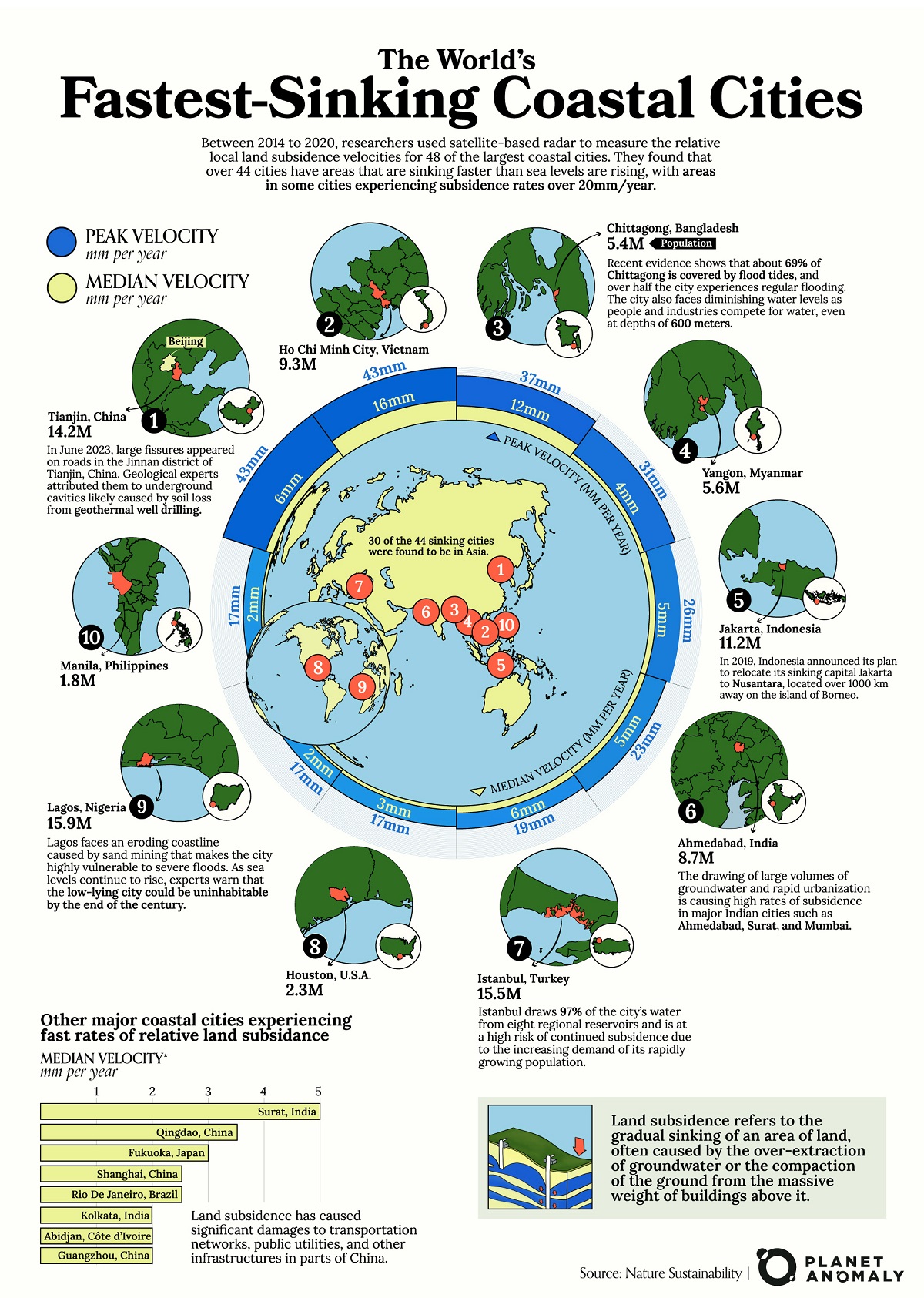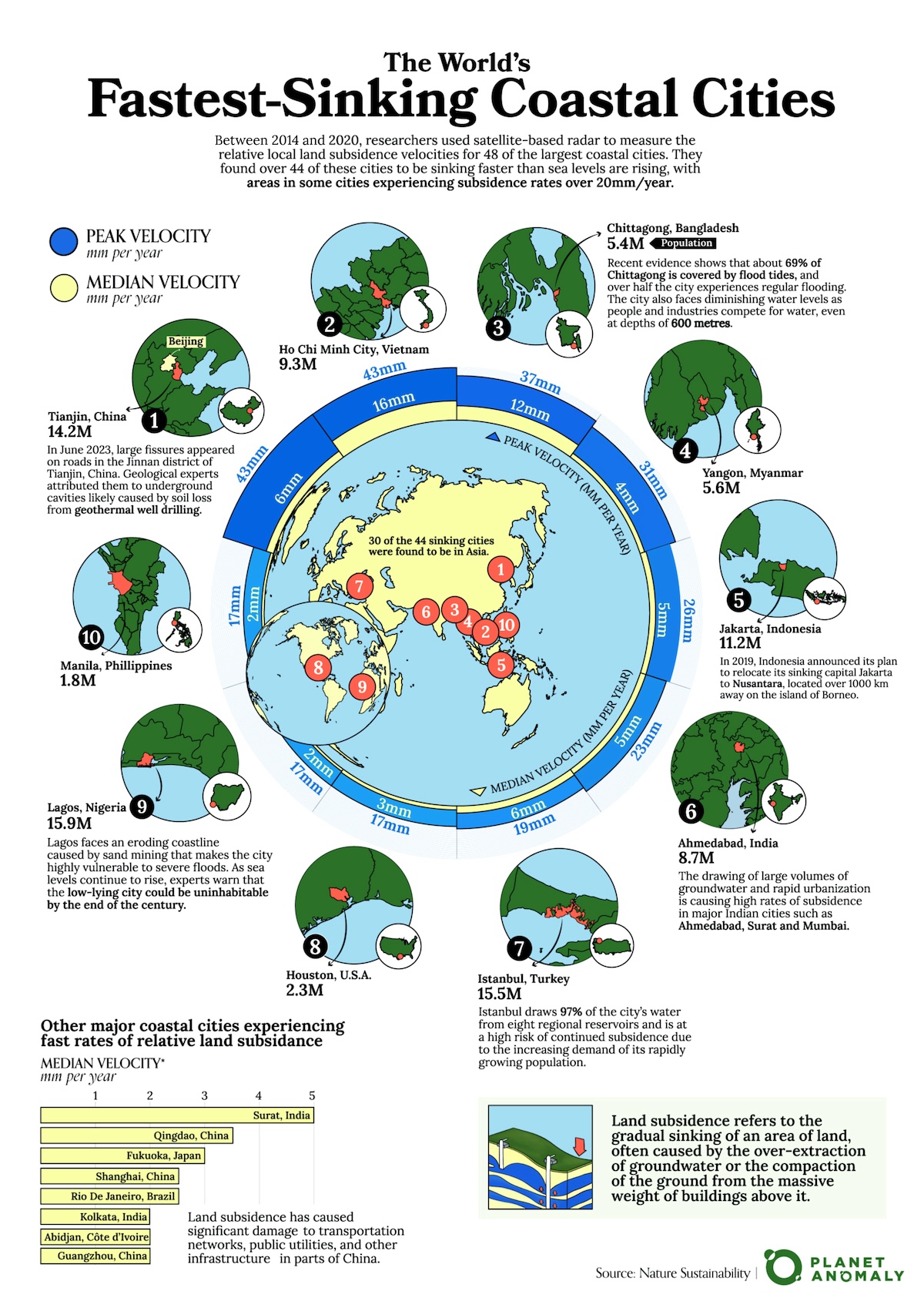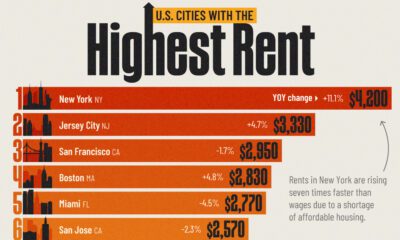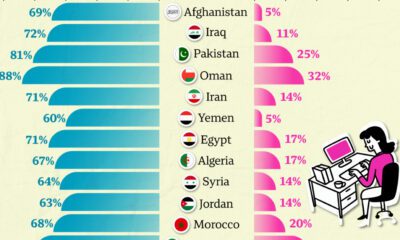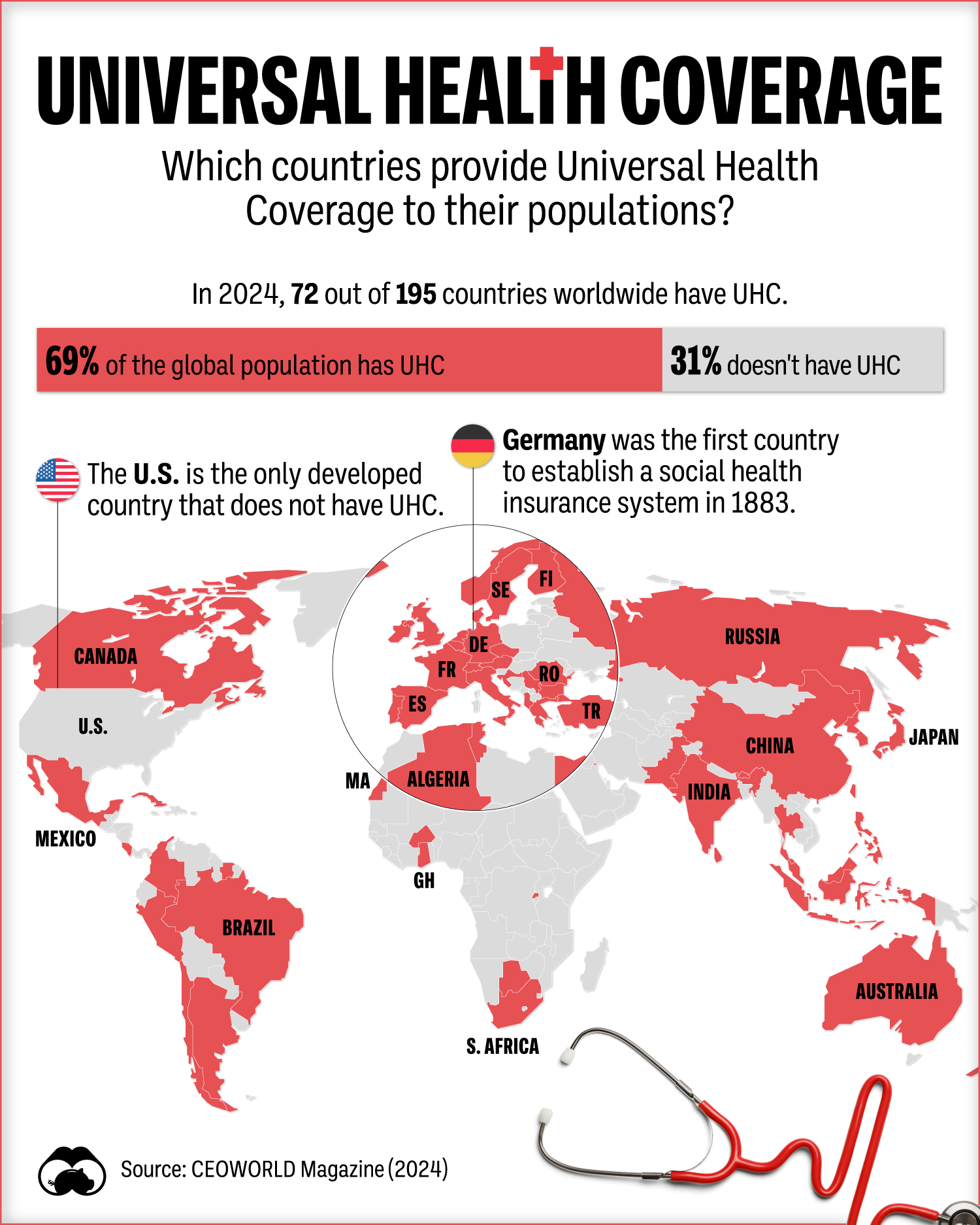Maps
Visualized: Which Coastal Cities are Sinking the Fastest?
![]() See this visualization first on the Voronoi app.
See this visualization first on the Voronoi app.
Which Coastal Cities Are Sinking the Fastest?
This was originally posted on our Voronoi app. Download the app for free on iOS or Android and discover incredible data-driven charts from a variety of trusted sources.
With sea levels rising, there is cause for concern about the livability of major coastal cities—often huge centers of trade and commerce, and homes to millions of people.
But an overlooked area is how coastal cities are themselves sinking—a phenomenon called relative local land subsidence (RLLS)—which occurs when underground materials, such as soil, rock, or even man-made structures, compact or collapse, causing the surface above to sink.
This can exacerbate the effects of rising sea levels (currently averaged at 3.7 mm/year), and is a useful metric to track for coastal communities.
Creator Planet Anomaly, looks at the top 10 cities ranked by the peak subsidence velocity. This graphic is based on a paper published by Nature Sustainability, which used satellite data to track land subsidence changes in 48 high-population coastal cities located within 50 kilometers of the coastline. Their data collection spanned six years from 2014 to 2020.
In that time period, they found that 44 of the cities they studied—many of them massively populated, developed megacities, built on flat, low-lying river deltas—had areas sinking faster than sea levels were rising.
The 10 Fastest Sinking Coastal Cities
One of the top cities on the list is Tianjin, China with a population of more than 14 million people, which has areas of the city experiencing peak RLLS velocities of 43 mm a year between 2014–2020. The median velocity is much lower, at 6 mm/year, which means some areas are sinking much faster than the overall metropolitan area.
Tianjin is bordered by Beijing municipality to the northwest and the Bohai Gulf to the east. In June 2023, large cracks appeared on Tianjin’s streets, caused by underground land collapses, a byproduct of extensive geothermal drilling, according to the local government.
| Rank | City | Country | Peak Velocity (mm/year) | Median Velocity (mm/year) |
|---|---|---|---|---|
| 1 | Tianjin | 🇨🇳 China | 43 | 6 |
| 2 | Ho Chi Minh City | 🇻🇳 Vietnam | 43 | 16 |
| 3 | Chittagong | 🇧🇩 Bangladesh | 37 | 12 |
| 4 | Yangon | 🇲🇲 Myanmar | 31 | 4 |
| 5 | Jakarta | 🇮🇩 Indonesia | 26 | 5 |
| 6 | Ahmedabad | 🇮🇳 India | 23 | 5 |
| 7 | Istanbul | 🇹🇷 Turkey | 19 | 6 |
| 8 | Houston | 🇺🇸 U.S. | 17 | 3 |
| 9 | Lagos | 🇳🇬 Nigeria | 17 | 2 |
| 10 | Manila | 🇵🇭 Philippines | 17 | 2 |
Ho Chi Minh City (population 9 million) in Vietnam also faces similar RLLS rates as Tianjin though its median velocity is much higher at 16 mm/year.
Chittagong, Bangladesh, Yangon, Myanmar, and Jakarta, Indonesia, round out the top five fastest sinking coastal cities by relative land subsidence. They all face a similar web of contributing factors as the authors of the paper note below:
“Many of these fast-subsiding coastal cities are rapidly expanding megacities, where anthropogenic factors, such as high demands for groundwater extraction and loading from densely constructed building structures, contribute to local land subsidence.” — Tay, C., Lindsey, E.O., Chin, S.T. et al.
In fact, Indonesia has ambitious plans to relocate its sinking capital, Jakarta, to another island, a move that could cost the Indonesian government more than $120 billion. This comes after the forecast that one-third of Jakarta could be submerged as early as 2050. Aside from the regular flooding, Jakarta is also extremely prone to earthquakes.
Why Measure Local Land Subsidence?
The researchers of this report argue that local land subsidence is largely underestimated in relative sea level rise assessments and is crucial for the sustainable development of coastal areas.
The data they’ve collected—peak velocity versus median velocity—also allows them to identify specific areas and neighborhoods in cities that are undergoing rapid subsidence and thus facing a greater exposure to coastal hazards.
In New York, for example, their results suggested that subsidence is only localized west of Breezy Point and “should not be extrapolated eastward along the coast” of Long Island.

This article was published as a part of Visual Capitalist's Creator Program, which features data-driven visuals from some of our favorite Creators around the world.
Healthcare
Which Countries Have Universal Health Coverage?
Most of the world population has universal health coverage (UHC). This map shows which countries do and don’t provide public health coverage.
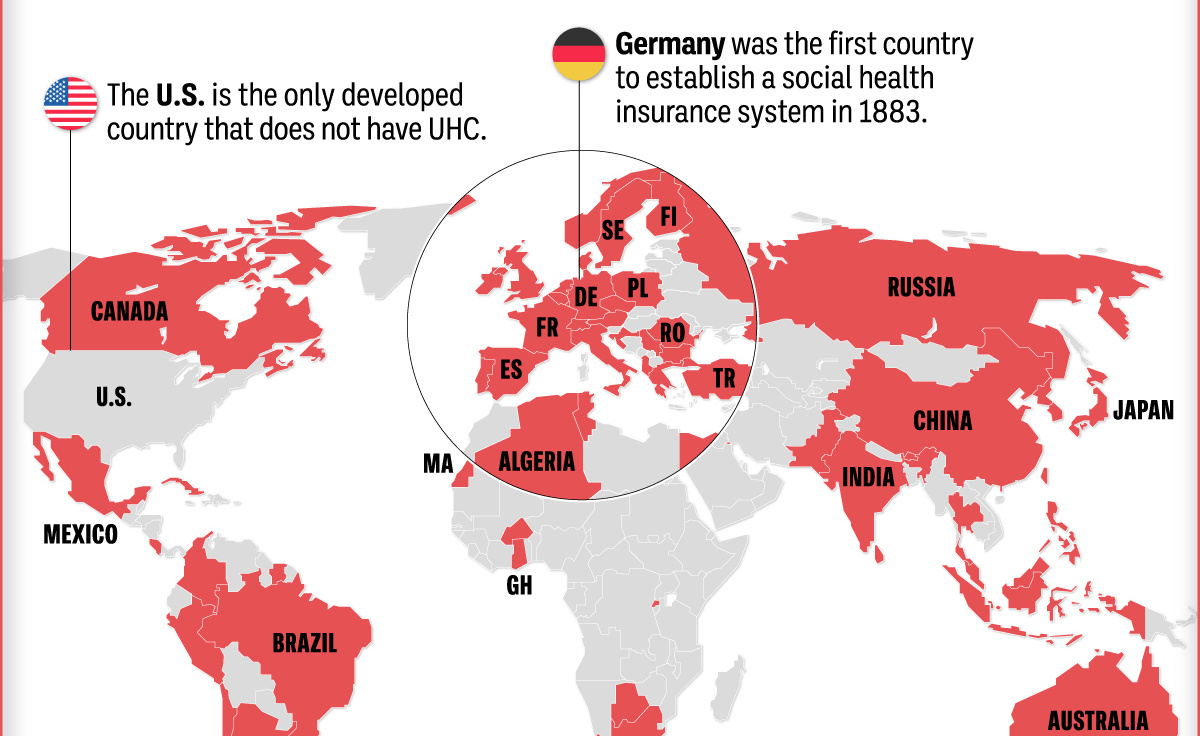
Which Countries Have Universal Health Coverage?
This was originally posted on our Voronoi app. Download the app for free on iOS or Android and discover incredible data-driven charts from a variety of trusted sources.
According to the World Health Organization (WHO), Universal Health Coverage (UHC) means that everyone has access to a full range of health services—from emergency interventions to palliative care—without financial difficulty.
In this graphic, we use data from CEOWorld Magazine to visualize the countries that have UHC versus those that do not, along with how UHC coverage breaks down in terms of the global population.
The State of Universal Health Coverage in the World
In 2024, 73 of the 195 countries worldwide had UHC, resulting in around 69% of the world’s population having some form of universal healthcare.
| Country | UHC? |
|---|---|
| Albania 🇦🇱 | Yes |
| Algeria 🇩🇿 | Yes |
| Argentina 🇦🇷 | Yes |
| Australia 🇦🇺 | Yes |
| Austria 🇦🇹 | Yes |
| Bahamas 🇧🇸 | Yes |
| Belgium 🇧🇪 | Yes |
| Bhutan 🇧🇹 | Yes |
| Botswana 🇧🇼 | Yes |
| Brazil 🇧🇷 | Yes |
| Bulgaria 🇧🇬 | Yes |
| Burkina Faso 🇧🇫 | Yes |
| Canada 🇨🇦 | Yes |
| Chile 🇨🇱 | Yes |
| China 🇨🇳 | Yes |
| Colombia 🇨🇴 | Yes |
| Costa Rica 🇨🇷 | Yes |
| Croatia 🇭🇷 | Yes |
| Cuba 🇨🇺 | Yes |
| Czech Republic 🇨🇿 | Yes |
| Denmark 🇩🇰 | Yes |
| Egypt 🇪🇬 | Yes |
| Finland 🇫🇮 | Yes |
| France 🇫🇷 | Yes |
| Georgia 🇬🇪 | Yes |
| Germany 🇩🇪 | Yes |
| Ghana 🇬🇭 | Yes |
| Greece 🇬🇷 | Yes |
| Hong Kong 🇭🇰 | Yes |
| Iceland 🇮🇸 | Yes |
| India 🇮🇳 | Yes |
| Indonesia 🇮🇩 | Yes |
| Ireland 🇮🇪 | Yes |
| Israel 🇮🇱 | Yes |
| Italy 🇮🇹 | Yes |
| Japan 🇯🇵 | Yes |
| Kuwait 🇰🇼 | Yes |
| Liechtenstein 🇱🇮 | Yes |
| Luxembourg 🇱🇺 | Yes |
| Macau 🇲🇴 | Yes |
| Malaysia 🇲🇾 | Yes |
| Maldives 🇲🇻 | Yes |
| Mauritius 🇲🇺 | Yes |
| Mexico 🇲🇽 | Yes |
| Morocco 🇲🇦 | Yes |
| Netherlands 🇳🇱 | Yes |
| New Zealand 🇳🇿 | Yes |
| North Korea 🇰🇵 | Yes |
| Norway 🇳🇴 | Yes |
| Pakistan 🇵🇰 | Yes |
| Peru 🇵🇪 | Yes |
| Philippines 🇵🇭 | Yes |
| Poland 🇵🇱 | Yes |
| Portugal 🇵🇹 | Yes |
| Romania 🇷🇴 | Yes |
| Russia 🇷🇺 | Yes |
| Rwanda 🇷🇼 | Yes |
| Serbia 🇷🇸 | Yes |
| Seychelles 🇸🇨 | Yes |
| Singapore 🇸🇬 | Yes |
| South Africa 🇿🇦 | Yes |
| South Korea 🇰🇷 | Yes |
| Spain 🇪🇸 | Yes |
| Sri Lanka 🇱🇰 | Yes |
| Suriname 🇸🇷 | Yes |
| Sweden 🇸🇪 | Yes |
| Switzerland 🇨🇭 | Yes |
| Taiwan 🇹🇼 | Yes |
| Thailand 🇹🇭 | Yes |
| Trinidad and Tobago 🇹🇹 | Yes |
| Tunisia 🇹🇳 | Yes |
| Turkey 🇹🇷 | Yes |
| United Kingdom 🇬🇧 | Yes |
The United States is the only developed country without health coverage for all of its citizens.
As of 2022, the Census Bureau estimated that only 36.1% of Americans were covered by public health insurance. Private health insurance covered 65.6% of the population. This along with other facts has led the U.S. having the world’s highest healthcare spending figure per capita.
The History of Public Health Coverage
Germany was the first country to establish a social health insurance system. Launched in 1883, the program began by covering only blue-collar workers, then slowly expanded its net of those covered.
The first international declaration underlying the need for adequate health care was the Declaration of Alma-Ata in 1978 at the International Conference on Primary Health Care in 1978. The conference’s target was to achieve global UHC by 2000.
The Ottawa Charter for Health Promotion of 1986 also reiterated the “Health for All by the year 2000” goal, ultimately paving the way for more countries to adopt UHC.
-

 Cryptocurrency5 days ago
Cryptocurrency5 days agoVisualizing the 15 Most Valuable Bitcoin Addresses
-

 Crime2 weeks ago
Crime2 weeks agoVisualizing the Companies Online Scammers Impersonate the Most
-

 Markets2 weeks ago
Markets2 weeks agoComparing Saudi Aramco’s $1.9T Valuation to Its Rivals
-

 Mining2 weeks ago
Mining2 weeks agoVisualizing Cobalt Production by Country in 2023
-
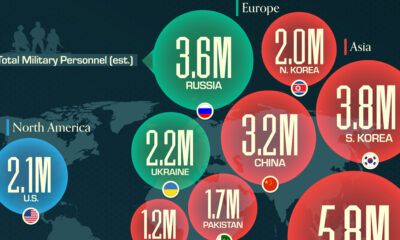
 War2 weeks ago
War2 weeks agoMapped: The World’s Largest Armies in 2024
-

 Demographics1 week ago
Demographics1 week agoCharted: America’s Most Popular Baby Names in 2023
-

 Technology1 week ago
Technology1 week agoVisualizing the Top Countries, by Mobile Data Usage
-

 Misc1 week ago
Misc1 week agoRanked: Top 10 Deadliest Animals for Humans

